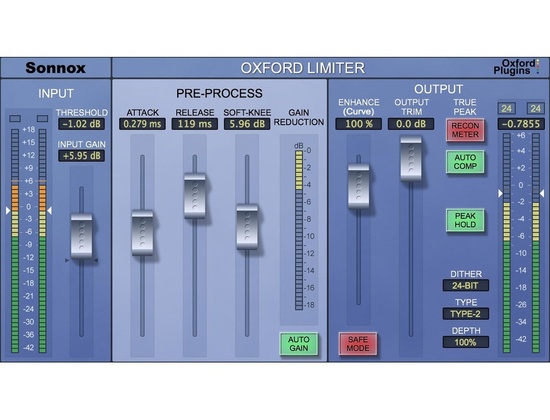


And second, it allows transient peaks to pass through the limiter algorithm and be dealt with by the Enhance function. First, it can be more transparent when you're using Oxford Limiter solely for long-term gain reduction rather than loudness maximising. Here, however, the ability to slow the attack time has two functions. Most limiters are simply designed to have as short an attack time as possible - in fact a limiter is sometimes defined as a compressor with instantaneous attack and an infinite compression ratio - and this is usually desirable, since the most prominent peaks in an input signal are often due to transient spikes that rise almost instantly. The most unusual feature of the limiter section, though, is the Attack time control, which is variable from 0.05ms to 1ms. As you'd expect, 'harder' settings give punchier results, but 'softer' ones often sound smoother and less obvious in action. To aid in the latter, the limiter's release time is variable up to 10 seconds, and there is also an Auto Gain button, in essence an automated volume control that can smooth out the kind of dynamic variations in the source material that occur over a timescale of seconds or even minutes.įurther control comes in the shape of a Soft Knee parameter, which can reduce the threshold at which limiting begins to take place from 0dB anywhere down to -10dB. The first is the kind of fast peak limiting required in order to maximise loudness without clipping, while the second is management of gain changes over a much longer period. Sony say that the limiter section was designed with two separate purposes in mind. The ability to detect and neutralise illegal inter-sample peaks can come in very handy even if you don't plan to use the limiter function at all. The output level meters go to +6dB in order to display these peaks when the Recon Meter button is selected, and a second button labelled Auto Comp automatically brings the level down for an instant whenever such a peak is encountered, providing either a safety net or a second layer of limiting, depending on how far you're pushing the output level. The limiter itself is a pretty comprehensive design, using lookahead detection to anticipate peaks and intelligent adaptive processing to tame them, and featuring a detection algorithm that is capable of spotting not only sample values that would hit 0dBFS, but also inter-sample peaks that might clip the D-A converter when the signal is reconstructed.
SONNOX OXFORD LIMITER DEMO MAC OS X
Oxford Limiter is available in TDM and RTAS formats on Mac OS X and Windows, and is authorised to an iLok key. This, it's claimed, can preserve fragile transient information even when the audio is being pushed hard against the end-stops, allowing you to achieve greater subjective loudness with less damage to the signal. However, Oxford Limiter also has a unique selling point in Sony's proprietary Enhance function. The idea behind Sony's Oxford Limiter is similar to that of Waves' L2 and many other wide-band mastering limiters: it can make your music louder without introducing clipping. I will be giving this some serious consideration as a stem sub master limiter.Like many of Sony Oxford's plug-ins, their new limiter takes a familiar concept and applies a novel twist. As many frequency bands as you want and a simple interface for what appears to be a pretty sophisticated engine - and the price is right. I just got this, so I haven't really used it on an active project, but it seems to be an absolute monster. I generally only use this when doing after-the-fact mastering of finished stereo mixes. But the more sophisticated algorithms like IRC IV add a bit of latency that may be too much if you're trying to sequence percussion or spiccato strings. Inter-sample peak detection / correction, and the Transient Recovery thing can really help avoid squashing the peaky stuff. Five frequency bands, very low latency allows you to leave it on all the time, even while recording new stuff, and it can do massive amounts of "louder-izing" while still sounding pretty invisible.

Waves 元-LL MultiMaximizer on stem sub masters.


 0 kommentar(er)
0 kommentar(er)
